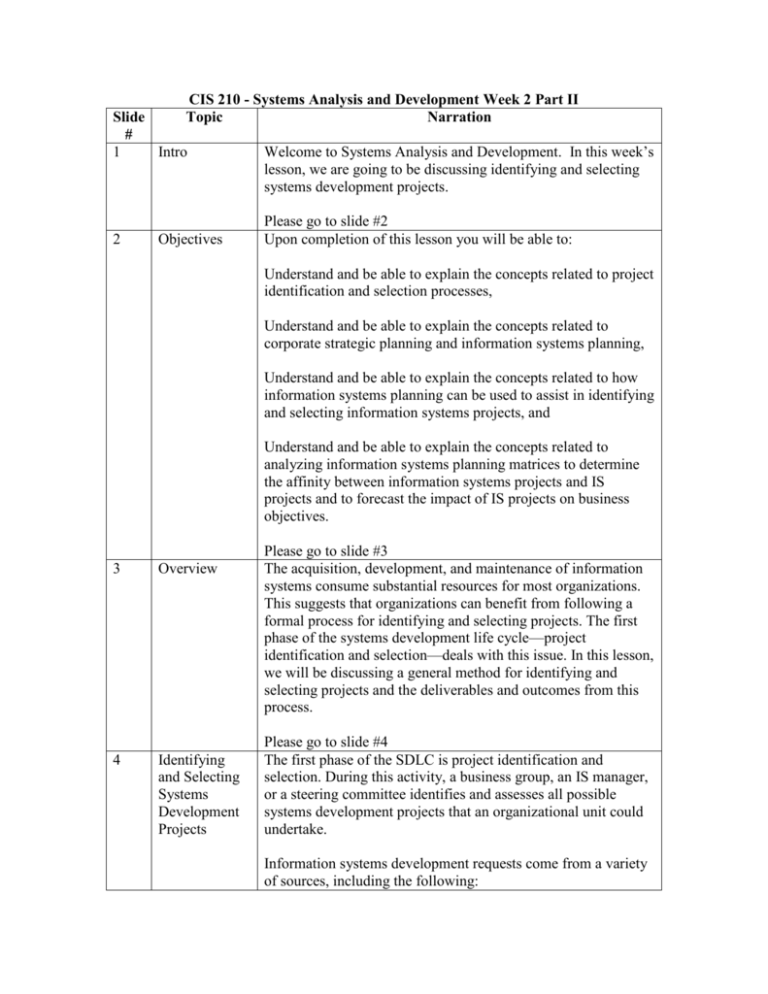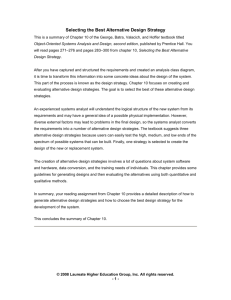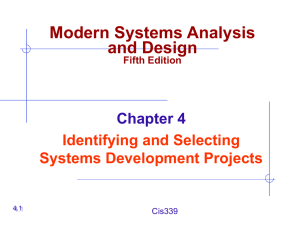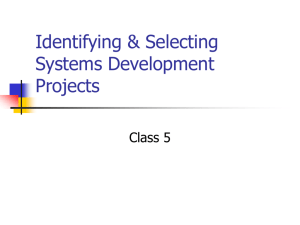ACC 305 Chapter 18
advertisement

CIS 210 - Systems Analysis and Development Week 2 Part II Topic Narration Slide # 1 Intro 2 Objectives Welcome to Systems Analysis and Development. In this week’s lesson, we are going to be discussing identifying and selecting systems development projects. Please go to slide #2 Upon completion of this lesson you will be able to: Understand and be able to explain the concepts related to project identification and selection processes, Understand and be able to explain the concepts related to corporate strategic planning and information systems planning, Understand and be able to explain the concepts related to how information systems planning can be used to assist in identifying and selecting information systems projects, and Understand and be able to explain the concepts related to analyzing information systems planning matrices to determine the affinity between information systems projects and IS projects and to forecast the impact of IS projects on business objectives. 3 4 Overview Identifying and Selecting Systems Development Projects Please go to slide #3 The acquisition, development, and maintenance of information systems consume substantial resources for most organizations. This suggests that organizations can benefit from following a formal process for identifying and selecting projects. The first phase of the systems development life cycle—project identification and selection—deals with this issue. In this lesson, we will be discussing a general method for identifying and selecting projects and the deliverables and outcomes from this process. Please go to slide #4 The first phase of the SDLC is project identification and selection. During this activity, a business group, an IS manager, or a steering committee identifies and assesses all possible systems development projects that an organizational unit could undertake. Information systems development requests come from a variety of sources, including the following: Requests by managers and business units for replacing or extending an existing system, IS managers who want to make a system more efficient and less costly to operate, and A formal planning group that identifies projects for improvement to help an organization meet its corporate objectives. Project identification and selection consists of the following three primary activities: Identifying potential development projects, Classifying and ranking IS development projects, and Selecting IS development projects. Projects are identified by both top-down and bottom-up initiatives. The formality of the process of identifying and selecting projects can vary substantially across organizations. Also, because limited resources include the development of all proposed systems, most organizations have some process of classifying and ranking the merit of each project. The second major activity in the project identification and selection process focuses on assessing the relative merit of potential projects. An important project evaluation method that is widely used for assessing information systems development projects is called value chain analysis. This is the process of analyzing an organization’s activities for making products or services to determine where value is added and costs are incurred. Information systems projects providing the greatest benefit to the value chain will be given priority over those with fewer benefits. The final activity in the project identification and selection process is the actual selection of project for further development. Project selection is a process of considering both short- and long-term projects and selecting those most likely to achieve business objectives. The identification and selection of projects is a very important, ongoing activity. Numerous factors must be considered when making projectselection decisions, including the following: Perceived needs of the organization, Existing systems and ongoing projects, Resource availability, Evaluation criteria, Current business conditions, and The perspectives of the decision makers. Acceptance of a project usually means that funding to conduct the next phase of the SDLC has been approved. Rejection means that the project will no longer be considered for development. The primary deliverable from the first SDLC phase is a schedule of specific IS development projects, coming from both topdown and bottom-up sources, to move into the next SDLC phase—project initiation and planning. An outcome of this phase is the assurance that careful consideration was given to project selection, with a clear understanding of how each project can help the organization reach its objectives. The principle of incremental commitment is a strategy in systems analysis and design in which the project is reviewed after each phase and continuation of the project is justified. Many organizations have found that in order to make good project selection decisions, a clear understanding of overall organizational business strategy and objectives is required. This means a clear understanding of the business and the desired role of information systems in achieving organizational goals is a precondition to improving the identification and selection process. 5 Corporate and Information Systems Planning Please go to slide #5 Although there are numerous motivations for carefully planning the identification and selection of projects, organizations have not traditionally used a systematic planning process when determining how to allocate IS resources. The challenge of most organizations is to design comprehensive information models containing data that are relatively independent from languages and programs used to access, create, and update them. To benefit from a planning-based approach for identifying and selecting projects, an organization must analyze its information needs and plan its projects carefully. Without careful planning, organizations may construct databases and systems that support individual processes, but do not provide a resource that can be easily shared throughout the organization. A prerequisite to making effective project selection decisions is to gain a clear idea of where an organization is, its vision of what it wants to be in the future, and how to make the transition to its desired future state. The process of developing and refining models of current and future enterprise, as well as a transition strategy, is often referred to as corporate strategic planning. During corporate strategic planning, executives typically develop a mission statement, statements of future corporate objectives, and strategies designed to help the organization reach its objectives. The mission statement typically states in very simple terms what business the company is in. Objective statements refer to broad and timeless goals for the organization. A competitive strategy is the method by which an organization attempts to achieve its mission and objectives. The second planning process that can play a significant role in the quality of project identification and selection decisions is called information systems planning, or ISP. Information systems planning is an orderly means of assessing the information needs of an organization and defining the information systems, databases, and technologies that will best satisfy those needs. Like corporate strategic planning, ISP is a three-step process in which the first step is to assess current IS-related assets—human resources, data, processes, and technologies. Next, target blueprints of these resources are developed. Finally a series of scheduled projects is defined to help move the organization from its current to its future desired state. A number of methodologies such as Business Systems Planning and Information Engineering have been developed to support the ISP process. Most contain the following three key activities: Describe the current situation; Describe the target situation, trends, and constraints; and Develop a transition strategy and plan. The IS plan is typically a very comprehensive document that looks at both short-and long-term organizational development needs. These needs identified in the plan are typically expressed as a series of projects. 6 E-Commerce Applications Please go to slide #6 The name “Internet” is derived from the concept of internetworking, that is, connecting host computers and their networks to form an even larger, global network. The Internet stands as the most prominent representation of global networking. Using the Internet to support day-to-day business activities is broadly referred to as electronic commerce, or EC. There are three general classes of Internet EC applications: Internets, intranet, and extranet. Intranet refers to the use of the Internet within the same business, and extranet refers to the use of the Internet between firms. Electronic Data Interchange, or EDI, refers to the use of telecommunications technologies to directly transfer business documents between organizations. Using EDI, trading partners establish computer-to-computer links that allow them to exchange data electronically. When developing either an intranet or an extranet, developers know who the users are, what applications will be used, the speed of the network, and the type of communication devices supported. On the other hand, when developing an Internet EC application, there are countless unknowns that developers have to discern in order to build a useful system. 7 Summary Please go to slide #7 We have now reached the end of this lesson, let’s take a look at the topics we have just covered: Classifying and ranking projects, Selecting projects, Deliverables and outcomes, Corporate strategic planning, Information systems planning, and E-commerce applications.











